Arena Națională: Steaua București / Romania
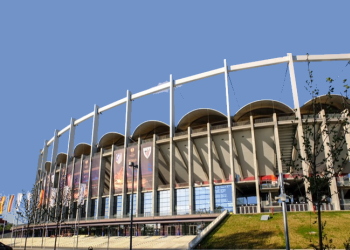
By VictorCozmei (Own work) [CC BY-SA 4.0], via Wikimedia Commons
The Arena Națională, or National Arena if you’d like the translation, opened in 2011 and is the biggest stadium in Romania. It was designed to replace the National Stadium and can be found inside the larger Lia Manoliu National Sports Complex in the city of Bucharest. As you might have guessed it is the location for all of Romania’s international matches, with Steaua București (FCSB) playing their games in the ground from 2015 onwards. Dinamo București also play some important games in the stadium, though they have a different home for most league games.
The stadium is capable of holding 55,634 people, though it rarely reaches anywhere near that figure for Steaua matches. The nature of the ground means that it can be used to host top matches not only from Romanian football but from Europe, too. It hosts the Romanian Cup Final and Supercup Final every year and in 2012 it was the venue for the final of the UEFA Europa League. It was also one of the venues used for the 60th anniversary of the European Championships, a pan-European event that occurred in 2020.
Stats
| Arena Națională Stats | |
|---|---|
| Year Opened | 2011 |
| Capacity | 55634 |
| Average Attendance | 21099 |
| Record Attendance | 53329 (Romania v Netherlands (2012)) |
| Pitch Size | 105 x 68 (7140) |
| Owner | Municipality of Bucharest |
| Clubs Hosted | Romania national football team, Dinamo București, Steaua București |
| First Fixture | Romania v France (06/09/2011) |
| Romania Stats | |
|---|---|
| Year Founded | 1909 |
| Nickname | Tricolorii (The Tricolours) |
| Rivals | Hungary |
| Previous Stadiums | Stadionul Național |
| Kit | Yellow with Red (Home) / Red with Yellow (Away) |
| Training Ground | Mogosoaia Stadium |
| Team Owner | Federația Română de Fotbal |
| Record Goalscorer | Gheorghe Hagi/Adrian Mutu (35) |
| Record Appearances | Dorinel Munteanu (134) |
| FC Steaua București Stats | |
|---|---|
| Year Founded | 1947 |
| Nickname | Roș-Albaștrii (The Red and Blues), Militarii (The Army Men), Viteziștii (The Speedsters) |
| Club Mascot | City Insurance |
| Rivals | Dinamo București, Rapid București, Universitatea Craiova, Politehnica Timișoara, Petrolul Ploiești, CFR Cluj, Universitatea Cluj, Astra Giurgiu |
| Previous Stadiums | Venus Stadium, ANEF, Republicii, 23 August, Stadionul Steaua |
| Kit | Red & Blue (Home) / White (Away) |
| Team Owner | George Becali |
| Record Goalscorer | Anghel Iordănescu (155) |
| Record Appearances | Tudorel Stoica (369) |
Arena Națională Photos
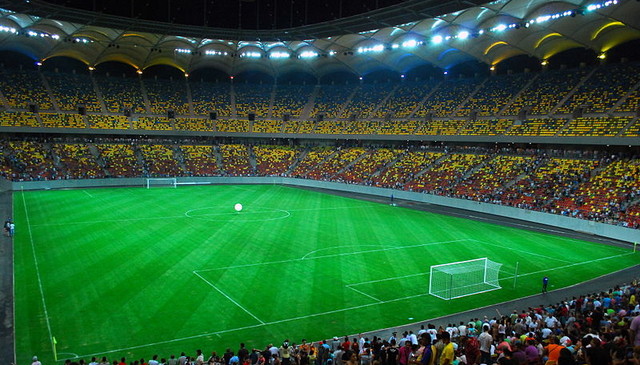
By Andrei Stroe (Own work) [CC BY-SA 3.0]
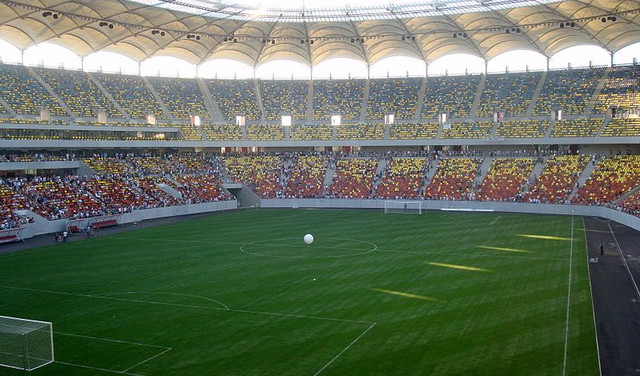
By Eugen Simion 14 [CC0]
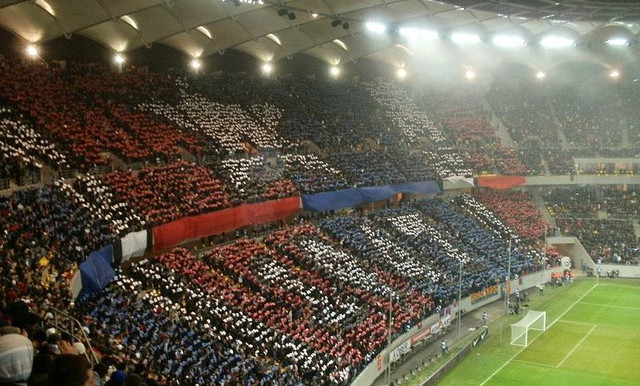
Arena Națională Seating Plan and Where to Sit

The Arena Națională has a bowl design to it, allowing for a ring of continuous seating around the pitch. This is as opposed to a more ‘English Style’ of a separate stand on each side. There are three tiers, with the middle one being a small section of VIP Seating. Here’s some info about each section:
- Peluza I Nord – The stadium’s North Stand is behind one of the goals and welcomes some of the more vocal football supporters into its midst.
- Peluza II Sud – The South Stand is directly opposite its Northern equivalent and is also prone to welcoming in vocal fans.
- Tribuna I Vest – The West Stand is typically considered to be the arena’s main stand, housing the dressing rooms, players’ tunnel and the dugouts. It also breaks with tradition when compared to the rest of the stadium by having a much bigger VIP section in the middle tier, with the director’s box being located here.
- Tribuna II Est – The East Stand is similar in design to the North and South stands, having a smaller VIP area and more room for average supporters. Much like the West Stand opposite, it runs along the entire edge of the pitch.
Romania Ticket Prices
Ticket prices for national matches vary throughout the world. It depends on who it is that the national side is going up against and what tournament they’re playing in. A friendly game against a side that no one in Romania particularly minds will cost a lot less than a World Cup qualifying match versus Hungary, for example. As the prices change from game to game it’s worth checking out the Romanian FA’s website for further details.
How To Get Romania Tickets
If you’d like to see the Tricolours play live then you’ll have to head to the website of the Federația Română de Fotbal and go from there. Oftentimes it is the runners of the competition themselves who dictate ticket prices, with FIFA in charge of the World Cup and UEFA bossing the European Championship, so you can head to their websites for more information too.
Where to Buy
FC Steaua București Ticket Prices
To be honest, ticket prices for the Romanian league aren’t exactly easy to come by. The club’s website is confusing with no clear instructions and Romanian newspaper articles aren’t much clearer. What we can tell you is that in the 2013-2014 season the club’s season ticket prices ranged from 199 lei through to about 1500 lei. That’s about £40 to £300, so it’s fair to guess that match tickets will be cheaper.
How To Get FC Steaua București Tickets
There is a website that you can go on, though you might struggle to understand what you’re signing up to if you don’t speak Romanian. There’s a ticket office phone number you can ring, too, but you might have the same problem there. You can also buy tickets directly from the stadium, should you be in Bucharest with time on your hands.
Where to Buy
Getting To Arena Națională
Bucharest is the capital city of Romania, as well as the largest one in the country. It isn’t impossible to get to but it isn’t all that easy either, depending on your method of transport. Here’s a look at the most common ones:
Train – Getting the train from London to Bucharest will take you first to Paris then on to Munich. You can then get a sleeper from Munich to Budapest Keleti Station, if you don’t mind travelling overnight.
Once in Bucharest the two best ways to get to the ground are either by tram or on the Metro. The closest Metro station is Piata Muncii, which is fifteen minutes away on foot. If you’d rather take the tram then any of trams 56, 46, 40, 36 and 14 serve the stadium, with Pictor Harlescu being the closest stop.
Bus – Arena Nationala bus and coach station is, unsurprisingly, the closet to the ground. It’s only served by the N109, though, so bus isn’t necessarily the best option open to you.
Car – You’d like to drive, hey? Good luck with that. Your best bet if you want to get where you’re going quickly and easily is to use a sat-nav and put in the stadium’s address.
By Air – The wonderfully named Bucharest Băneasa Aurel Vlaicu International Airport is less than ten miles from the city centre and is the biggest one that serves the city. Around fifteen miles away is Henri Coanda International Airport, which caters to both domestic and international flights.
Taxi – An Uber from Budapest Central Station to the ground will take about twenty or so minutes and should cost you in the region of 20 lei.
Parking Near Arena Națională
There are 2100 parking spaces at the stadium, though priority for their usage goes to VIP guests. Still, you might be able to get a spot if you’re there early enough.
Useful Resources
Arena Națională Hotels
Capital cities usually have plenty of hotels and Bucharest is no exception. Here are some of our favourite places to stay in the largest city in Romania:
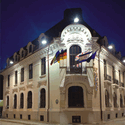
Le Boutique Hotel Moxa - £60+
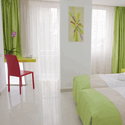
Hotel Christina - £70+
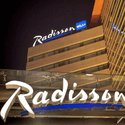
Radisson BLU Bucharest - £90+
Pubs and Bars Near Arena Națională
Romania is a cracking place to go for a drink and a bite to eat. Here are some of the best places we’ve experienced:
St. Patrick
Rocca by the Jar
The Pub Bucharest
Facilities
The stadium contains all of the usual facilities that you’d expect for a ground that hosts the games of both the national side and the most successful club side in the country. There are plenty of places to eat and drink before and during the match, as well as lots of comfortable seats throughout. There’s also a retractable roof, if you’re interested in that sort of thing.
Hospitality
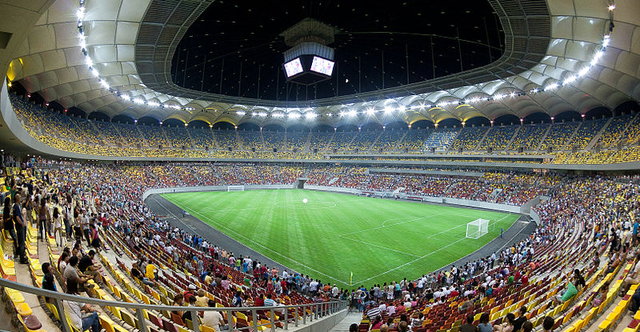
It isn’t all that easy to discover hospitality information for matches held at the Arena Națională. What we can say, however, is that the ground has plenty of locations for your to enjoy the match in style from. As well as the usual comfortable seat sections there are also lodges and executive boxes running around the entire ground. In short, if you want to watch the game in extreme comfort then you’ll definitely be able to. After all, there are 3,600 VIP seats inside the ground.
Private Hire
Much like with the hospitality packages available, we can’t tell you a whole heap about private hire options. The stadium is full of amazing lounges and rooms that would definitely work for hosting a conference or meeting, though, so if it’s something you’re really desperate to do then we feel confident in saying that you’ll be able to.
Stadium Tours & Museum
The stadium tour is run by Steaua, so it’s unsurprising that it is the club side’s information that dominates your visit. You’ll get to have a look at the team’s tour bus, the training pitches, the gym that the players use and the press room. You’ll also get to walk down the players’ tunnel, pretend you’re getting interviewed and have a walk across the pitch on some specially designed tiles. There’s the chance to have a sit on the bench, go into the changing rooms and have a look around the club’s museum.
Tours run from Monday – Saturday as long as there isn’t a match on, taking place at 10am, 12pm, 2pm and 4pm. It costs 50 lei if you’re a full price paying adult, 25 lei if you’re a concession and it’s free for kids under six.
About Romania
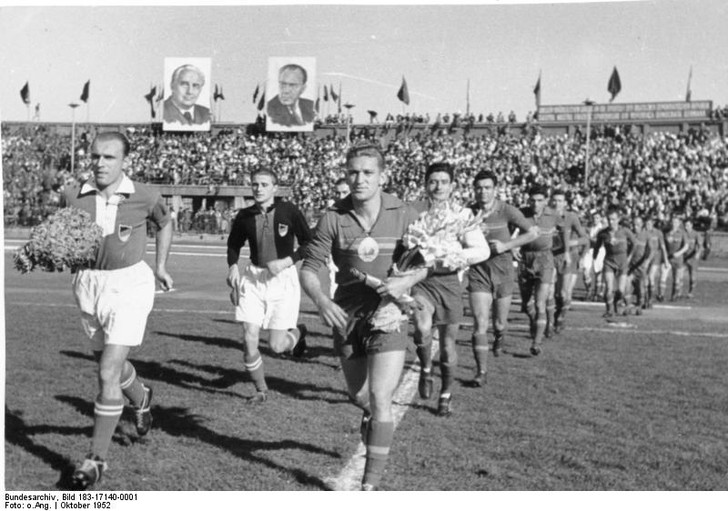
Echipa națională de fotbal a României, or the Romanian national football team to me and you, was formed in 1909 under the leadership of the newly created Romanian Football Federation. It didn’t actually play its first international match until 1922, however, when Romania took on Yugoslavia and won 2-1. They are one of just four European teams that part in the first ever World Cup back in 1930, with the others being Yugoslavia, Belgium and France. They qualified for the other two World Cups of the 1930s too, something only achieved by them, Brazil, France and Belgium.
After the 1938 tournament then Romanians weren’t seen in the World Cup again until 1970 when they qualified for the tournament in Mexico. The country’s best performance in the World Cup came 24 years later when they reached the quarter-finals of the tournament when it was held in the United States. Their most successful tilt at the European Championships came in 2000 when the tournament was co-hosted by Belgium and the Netherlands and they once again made it to the quarter-finals. Interestingly, their best performance in the Summer Olympics also saw them reach the quarter-final stage back in 1964.
About FC Steaua București

Steaua Bucharest are one of several teams located in the country’s largest city. It just so happens that they’re also the most successful, having spent their entire existence in the Romanian Liga I. Over the years they have picked up 26 top-flight titles, 24 Romanian Cups, 6 Romanian SuperCups and 2 League Cups. They have won both the European Cup and the European Super Cup, narrowly missing out on a second European Cup when they lost 4-0 to AC Milan in the final.
The club was formed in 1947 by officers of the Romanian Royal House and its original name was Asociația Sportivă a Armatei București, or Army Sports Association. Indeed, even to this day it is known as the Romanian Army Sports Club, despite separating the football side of things back in 1998. Perhaps unsurprisingly given the side’s success, Steaua is the best supported club in the country. More than 40% of all Romanians are believed to support The Army Men.
Arena Națională History
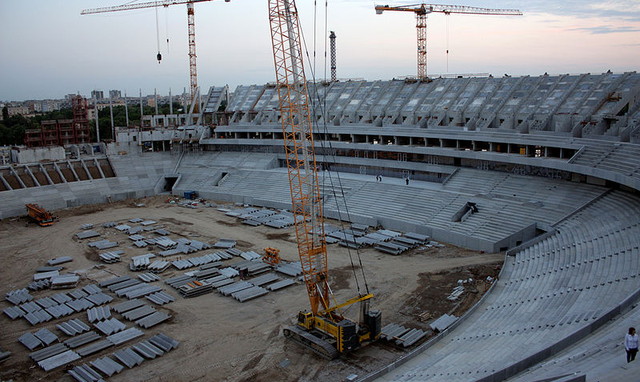
The biggest stadium in Romania officially opened its doors for the first time on the sixth of September 2011 when France turned up for a European Championship qualifying game. It ended 0-0 and was attended by just shy of 50,000 people. The ground was actually supposed to open on the 11th of August that year with a friendly game against Argentina, but the Argentines cancelled the game at the end of July after sacking their manager.
The construction of the stadium was hampered by numerous delays, with the mayor of Bucharest stating in 2009 that the building works were twenty weeks behind schedule. Later that year constructions was delayed further when a decision was taken to add a roof to the stadium at a cost of €20 million. The retractable roof can be open or closed within about fifteen minutes; something that would have been at the end of 2009 when building work was hampered by poor weather conditions.
Future Developments

The stadium was considered to be state-of-the-art when it opened in 2012, so there are unlikely to be too many developments until we get a little further into the future. If anything changes on that front then we’ll let you know.
